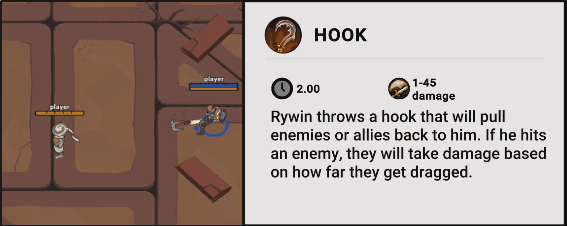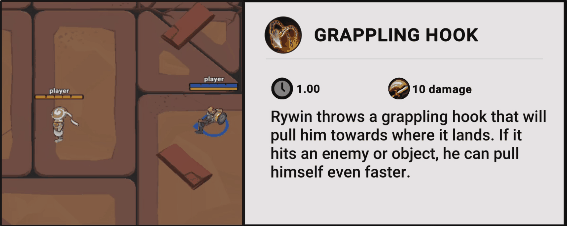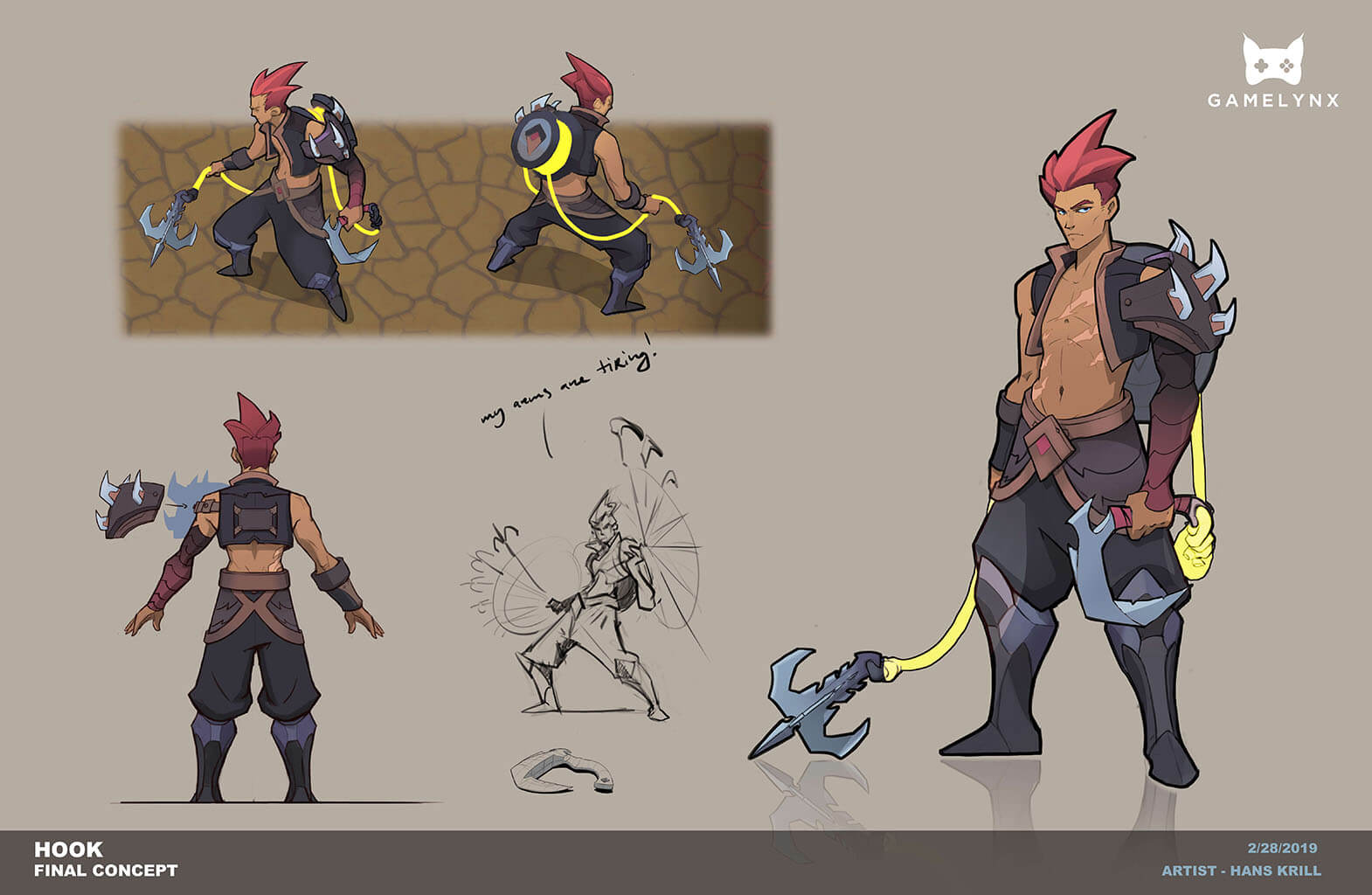Combat Design: The Hook Class in Element Arena

Hook characters are typically tough hulking characters like Pudge, Blitzcrank, and Roadhog. They use their hook to yank players close and finish them before they get away. My contribution to the design space was to turn that tanky archetype on it's head. The goal was to make an mobile skirmisher would pull you in but then they were the ones who wanted to get away after!
Below is the Hook class design summary, which serves to align the team on a Class' unique aspects and playstyle before designing the kit. Even on a small team it was critical to keep the framework for and the identities of classes clear, so that any team member could tweak or prototype changes for the class without taking it in a different overall direction.
Hook Class
An agile fighter that pulls enemies close with a hook, and zips away with a grappling hook. They fight on their terms, looking for the best chance to strike.
Power Fantasy
Turn the archetypical hooking hulk character on it's head. Agile, swift, with the same hook ability players love. Eats ranged characters for lunch, and runs from the strong melee damagers.
Reference
Attack of Titan omni-directional mobility gear
Pudge from Dota 2
Power Budget
2/5 melee power
5/5 ranged power [5 factoring in utility, not only damage]
4/5 movement power
2/5 defense power
Mastery Variants and Combos
[These are the attacks you get through move-chaining or through charging up moves]
Combo with the hook for almost a zero to 100% damage kill. Low protection, but able to disarm or disrupt long enough to have a chance to get away.




The Making Of A Playstyle
Every character in Element Arena has a ranged ability, melee ability, dash ability, and defense ability. From there other variants and combo abilities are possible depending on input. One of our guiding principles for abilities to make them part of "The Greatest Hits Playlist of MOBA Abilities." We wanted to keep the set of abilities minimal, impactful and recognizable.
So it was obvious the ranged ability would the be the classic hook from MOBA games. It pulls enemies in and damages them based on distance dragged. It can also pull allies for no damage. The hook would be the central starting point to their offensive attacks.
After some ideation, the dash ability took shape as a grappling hook. The dual hooks made sense with the class' proficiency in hooks, and it resonated well with the hook itself. You could pull others with the Hook and pull yourself a lesser distance with the Grappling Hook. If you combo a hook with a 180 degree turn into a grappling hook, you could execute a super long hook pull.
I threw the reflect shield and a standard sword ability to fill the final slots and started playtesting. Our teammate John was so good at lurking in the back looking for maximum distance the double hook combo. He even fit in a of couple running steps before using the grappling hook for extra oomph. It was 1 hit killing everyone (all classes have 100 health). Immediately it was his favorite character and I had work to do to make it less devastating but still fun for him.
Besides the one hit kill fiasco, I learned two other things that didn't feel right:
- Players were using the standard sword ability to fight head to head with the melee damagers, and then hooking them as they tried to escape. They didn't need to use their hooks to stay moving or setup the engagement.
- By having the reflect shield, ranged damagers felt that they had no chance. They were most vulnerable to a hook, and also shooting projectiles at a player who reflects them back hurt badly. They were simply running and not engaging.
Obviously, I didn't expect it to be balanced with kit-bashed abilities, but I gained a refined sense of what the dynamics should be. We wanted the hook class to be vulnerable to both ranged and melee attacks, and only seek fights on their terms. At this point, I knew enough to articulate the class design document, take a stab at creating the last two abilities and keep iterating.
The last abilities ended up being ones that don't do a lot of damage, but serve as a way for the Hook class to create space and release the tension they build when pulling someone close.
- Right Hook, a weak melee attack that gets empowered with slight knockback when comboed with the Hook
- Push Kick, a barely damaging attack that pushes away enemies. Empowers when comboed with the Hook to push further and add a small bit of stun.
By empowering specifically with the hook ability, we give an increased sense of synergy and dependence on the hook ability. It guarantees the hook ability is on cooldown when the captured players are most vulnerable. If you do the double hook combo, you'll do 80-90% of their health and the prey has a few frames to escape before you can pile on enough damage to finish things. It's at this point where the Hook class player must decide if they are going to offensively dive in to finish what they started or retreat to setup another combo.

